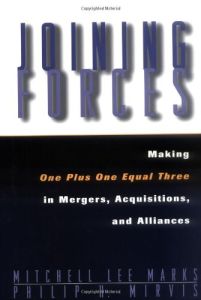Join getAbstract to access the summary!

Join getAbstract to access the summary!
Mitchell Lee Marks and Philip Mirvis
Joining Forces
Making One Plus One Equal Three in Mergers
Jossey-Bass, 1998
What's inside?
Merger Checklist: 1) Finance deal with outrageously overvalued stock; 2) Vanquish new partners to subordinate roles; 3) Compassionately counsel remaining employees on “survival guilt.” Haven’t gotten to number three yet? Read Joining Forces.
Recommendation
Many mergers, acquisitions and alliances fail due to lack of preparation before, lack of care during, or lack of focus after the deal. Joining Forces is a sober, to-the-point manual directed at business leaders who want to provoke successful combinations, as well as managers and employees who have to deal with the burdens, both mental and physical, of combinations. For the past decade, corporate America has embraced M&A – often with mixed results – and the consolidation pace seems to be accelerating. But too few people inside and outside of the companies involved understand what the combination process means or how it should be handled. Organizations must be willing to focus on the psychological impacts of a combination on their employees. Joining Forces provides a rough sketch of how this can be accomplished – minus any unnecessary strategic details or legalese. getAbstract recommends this book to executives, managers and employees at every level – all of whom probably will have to face the realities of corporate consolidation some day.
Summary
About the Authors
Mitchell Lee Marks has worked at the center of some of the largest mergers of the past decade. He currently works as an independent management consultant. He is coauthor of the widely read Managing the Merger with Philip H. Mirvis Mirvis, who works as an organizational researcher and consultant, has published widely for both professional and academic audiences.
















Comment on this summary